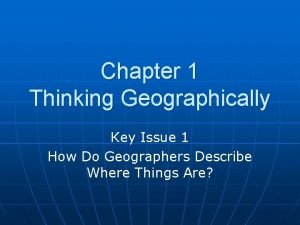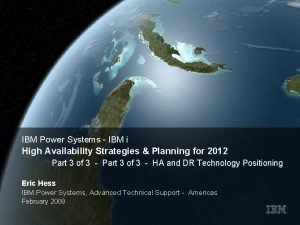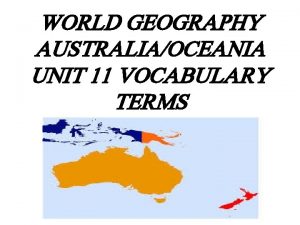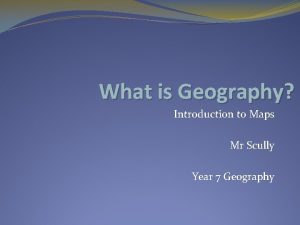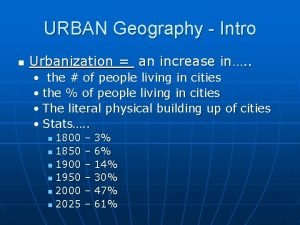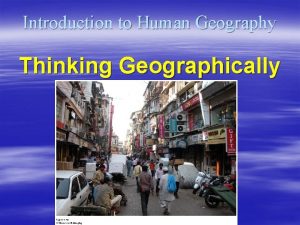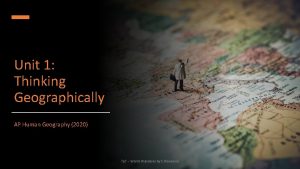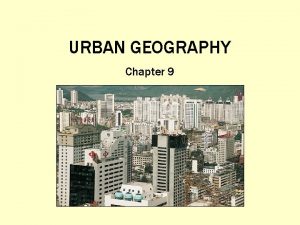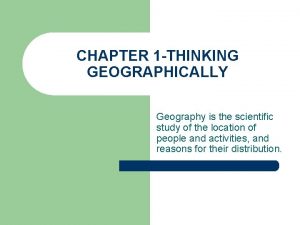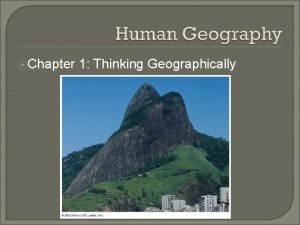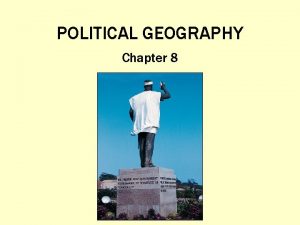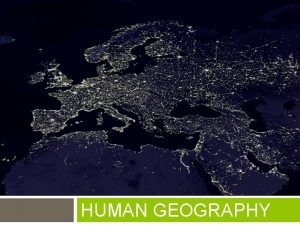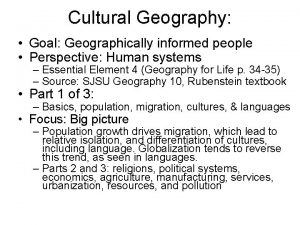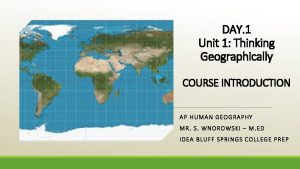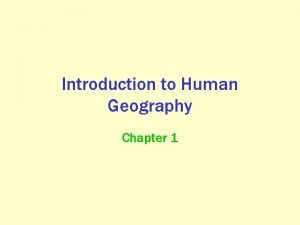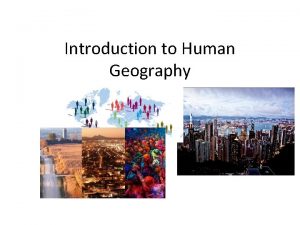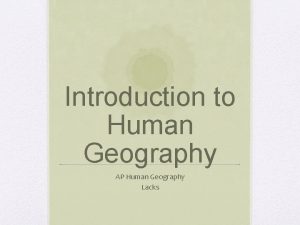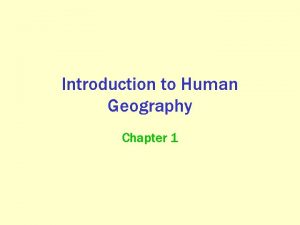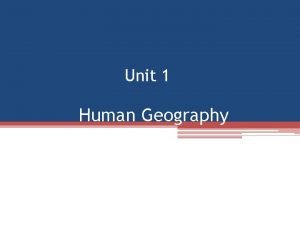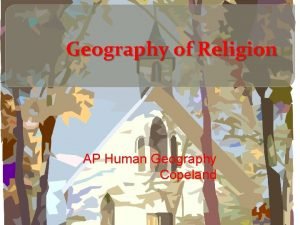Thinking Geographically Introduction to AP Human Geography It




























- Slides: 28

Thinking Geographically Introduction to AP Human Geography: It all begins…….

What is Human Geography anyway? • I. Word coined by Eratosthenes • Geo = Earth • Graphia = writing • Geography thus means “earth writing” • II. What it is. . And what is isn’t. . ? ? ? • It is NOT a discipline in simply rote memorization of places, and natural features. . • It is an in-depth, analytical study of “why” people, places and things are where they are, how they interact with the natural environment, AND how they interact with each other. . .

Case Study: • Big Mac Attack

Essential Questions: • Key Issue #1: How do geographers describe where things are? • Key Issue #2: Why is each point on the earth unique? • Key Issue #3: Why are different places similar?

Five Themes of Geography • Geographers use the 5 Themes of Geography to study and learn about the world. They include: • Location • Place • Human Environment Interaction • Movement • Regions

How do geographers describe where things are? • Maps: • What is it? Why use it? • Scale- Large vs. Small

How do Geographers Describe a Place? • Projection • Shape • Size • Distance • Direction • Most Commonly Used Projections: • Mercator • Robinson • Advantages and Disadvantages of each

How do geographers describe a place? • Satellite Based Imagery: • GPS • http: //media. defenceindustrydaily. co m/images/PUB_How_GPS_Works_ lg. jpg • Remote Sensing • GIS

Why is each point on Earth unique? A. Place: Unique Location of a Feature 1. Toponym is the name given to a place on Earth 1. Site is the physical character of a place. Includes climate, water sources, topography, soil, vegetation, latitude, and elevation

Site: Lower Manhattan Island Fig. 1 -6: Site of lower Manhattan Island, New York City. There have been many changes to the area over the last 200 years.

Why is each point on Earth unique? 3. Situation : The location of a place relative to other places. Situation helps us find an unfamiliar place by comparing its location with a familiar one. Situation, also, helps us understand the importance of a location. What is the situation of Phoenixville?

Situation: Singapore Fig. 1 -7: Singapore is situated at a key location for international trade.

Downtown Singapore

Why is each point on Earth unique? 4. Mathematical location: 5. http: //geographyworldonline. com/tutori al/practice. html Latitude Longitude Prime Meridian Time Zones

World Geographic Grid Fig. 1 -8: The world geographic grid consists of meridians of longitude and parallels of latitude. The prime meridian ( 0º) passes through Greenwich, England.

World Time Zones Fig. 1 -9: The world’s 24 standard time zones each represent about 15° of longitude. They are often depicted using the Mercator projection.

Why is each point on Earth unique? B. Regions: Areas of Unique Characteristics 1. What is meant by cultural landscape? 2. Types of Regions Functional Formal Vernacular

Formal and Functional Regions Fig. 1 -11: The state of Iowa is an example of a formal region; the areas of influence of various television stations are examples of functional regions.

Vernacular Regions Fig. 1 -12: A number of features are often used to define the South as a vernacular region, each of which identifies somewhat different boundaries.

Why is Each Point on Earth Unique? • What is meant by spatial association? http: //images. slideplayer. com/2/71 9530/slides/slide_25. jpg • What is culture? • How does culture contribute to spatial association?

Why is each point on the earth unique? • Cultural Ecology: Determinism vs. Possibilism • • Climate Vegetation Soil Landforms

Why are different places similar? 1. Globalization: The Good and the Bad… 1. Economy 2. Culture

Distribution: Density, Concentration, & Pattern 2. Distribution of features Density is the frequency with which something occurs in space Concentration is the extent of a feature’s spread over space Pattern is the geometric arrangement of objects in space Fig. 1 -18: The density, concentration, and pattern (of houses in this example) may vary in an area or landscape.

Density and Concentration of Baseball Teams, 1952 & 2007 Fig. 1 -19: The changing distribution of North American baseball teams illustrates the differences between density and concentration.

U. S. Baseball Teams, 1952 Fig. 1 -19: Baseball teams were highly concentrated in the Northeast and Midwest in 1952.

U. S. Baseball Teams, 2007 Fig. 1 -19: By 2007, U. S. baseball teams were much more dispersed than in 1952, and their number and density at a national level had increased.

Why are different places similar? Spatial Interaction: How do regions affect each other? a) Space-time compression a) Distance decay

Why are different places similar? a) Diffusion
 Thinking geographically key issue 1
Thinking geographically key issue 1 Scotland is divided into
Scotland is divided into Where are the nacirema located geographically
Where are the nacirema located geographically Geographically concentrated buyers
Geographically concentrated buyers Ibm geographically dispersed resiliency for power systems
Ibm geographically dispersed resiliency for power systems Ibm high availability solutions
Ibm high availability solutions Parallel sysplex licence charge
Parallel sysplex licence charge Ap human geography frq format
Ap human geography frq format 5 themes of geography ap human geography
5 themes of geography ap human geography Proruption ap human geography
Proruption ap human geography Gni definition ap human geography
Gni definition ap human geography Positive thinking vs negative thinking examples
Positive thinking vs negative thinking examples Thinking about your own thinking
Thinking about your own thinking Holistic thinking example
Holistic thinking example Perbedaan critical thinking dan creative thinking
Perbedaan critical thinking dan creative thinking Thinking about you thinking about me
Thinking about you thinking about me Positive attitude introduction
Positive attitude introduction An introduction to critical thinking and creativity
An introduction to critical thinking and creativity Whats round robin
Whats round robin Ap human geography chapter 11 vocab
Ap human geography chapter 11 vocab Topographic map definition ap human geography
Topographic map definition ap human geography Alpha beta gamma cities ap human geography
Alpha beta gamma cities ap human geography Elongated states
Elongated states Alfred webers least cost theory
Alfred webers least cost theory Na von model
Na von model Thnen
Thnen Von thunen model pros and cons
Von thunen model pros and cons Spatial association ap human geography
Spatial association ap human geography Bid rent theory example
Bid rent theory example
